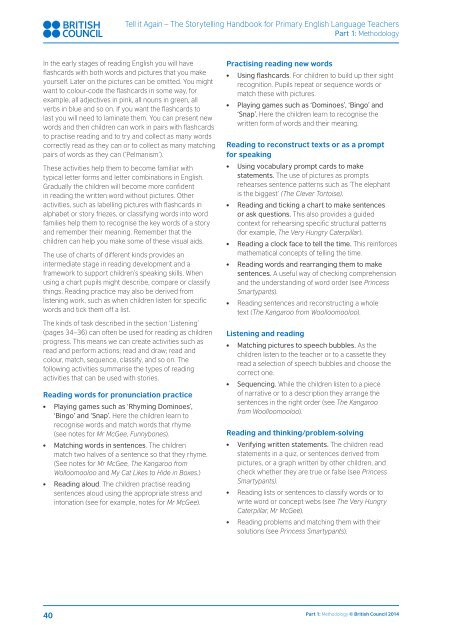1nW0gvB
1nW0gvB
1nW0gvB
You also want an ePaper? Increase the reach of your titles
YUMPU automatically turns print PDFs into web optimized ePapers that Google loves.
Tell it Again – The Storytelling Handbook for Primary English Language Teachers<br />
Part 1: Methodology<br />
In the early stages of reading English you will have<br />
flashcards with both words and pictures that you make<br />
yourself. Later on the pictures can be omitted. You might<br />
want to colour-code the flashcards in some way, for<br />
example, all adjectives in pink, all nouns in green, all<br />
verbs in blue and so on. If you want the flashcards to<br />
last you will need to laminate them. You can present new<br />
words and then children can work in pairs with flashcards<br />
to practise reading and to try and collect as many words<br />
correctly read as they can or to collect as many matching<br />
pairs of words as they can (‘Pelmanism’).<br />
These activities help them to become familiar with<br />
typical letter forms and letter combinations in English.<br />
Gradually the children will become more confident<br />
in reading the written word without pictures. Other<br />
activities, such as labelling pictures with flashcards in<br />
alphabet or story friezes, or classifying words into word<br />
families help them to recognise the key words of a story<br />
and remember their meaning. Remember that the<br />
children can help you make some of these visual aids.<br />
The use of charts of different kinds provides an<br />
intermediate stage in reading development and a<br />
framework to support children’s speaking skills. When<br />
using a chart pupils might describe, compare or classify<br />
things. Reading practice may also be derived from<br />
listening work, such as when children listen for specific<br />
words and tick them off a list.<br />
The kinds of task described in the section ‘Listening’<br />
(pages 34–36) can often be used for reading as children<br />
progress. This means we can create activities such as<br />
read and perform actions; read and draw; read and<br />
colour, match, sequence, classify, and so on. The<br />
following activities summarise the types of reading<br />
activities that can be used with stories.<br />
Reading words for pronunciation practice<br />
●●<br />
●●<br />
●●<br />
Playing games such as ‘Rhyming Dominoes’,<br />
‘Bingo’ and ‘Snap’. Here the children learn to<br />
recognise words and match words that rhyme<br />
(see notes for Mr McGee, Funnybones).<br />
Matching words in sentences. The children<br />
match two halves of a sentence so that they rhyme.<br />
(See notes for Mr McGee, The Kangaroo from<br />
Wolloomooloo and My Cat Likes to Hide in Boxes.)<br />
Reading aloud. The children practise reading<br />
sentences aloud using the appropriate stress and<br />
intonation (see for example, notes for Mr McGee).<br />
Practising reading new words<br />
●●<br />
●●<br />
Using flashcards. For children to build up their sight<br />
recognition. Pupils repeat or sequence words or<br />
match these with pictures.<br />
Playing games such as ‘Dominoes’, ‘Bingo’ and<br />
‘Snap’. Here the children learn to recognise the<br />
written form of words and their meaning.<br />
Reading to reconstruct texts or as a prompt<br />
for speaking<br />
●●<br />
●●<br />
●●<br />
●●<br />
●●<br />
Using vocabulary prompt cards to make<br />
statements. The use of pictures as prompts<br />
rehearses sentence patterns such as ‘The elephant<br />
is the biggest’ (The Clever Tortoise).<br />
Reading and ticking a chart to make sentences<br />
or ask questions. This also provides a guided<br />
context for rehearsing specific structural patterns<br />
(for example, The Very Hungry Caterpillar).<br />
Reading a clock face to tell the time. This reinforces<br />
mathematical concepts of telling the time.<br />
Reading words and rearranging them to make<br />
sentences. A useful way of checking comprehension<br />
and the understanding of word order (see Princess<br />
Smartypants).<br />
Reading sentences and reconstructing a whole<br />
text (The Kangaroo from Woolloomooloo).<br />
Listening and reading<br />
●●<br />
●●<br />
Matching pictures to speech bubbles. As the<br />
children listen to the teacher or to a cassette they<br />
read a selection of speech bubbles and choose the<br />
correct one.<br />
Sequencing. While the children listen to a piece<br />
of narrative or to a description they arrange the<br />
sentences in the right order (see The Kangaroo<br />
from Woolloomooloo).<br />
Reading and thinking/problem-solving<br />
●●<br />
●●<br />
●●<br />
Verifying written statements. The children read<br />
statements in a quiz, or sentences derived from<br />
pictures, or a graph written by other children, and<br />
check whether they are true or false (see Princess<br />
Smartypants).<br />
Reading lists or sentences to classify words or to<br />
write word or concept webs (see The Very Hungry<br />
Caterpillar, Mr McGee).<br />
Reading problems and matching them with their<br />
solutions (see Princess Smartypants).<br />
40<br />
Part 1: Methodology © British Council 2014


